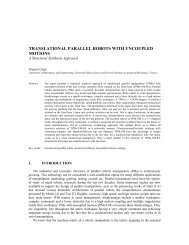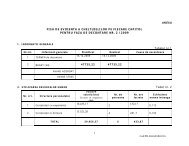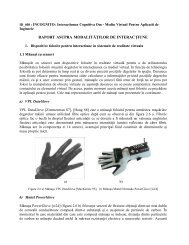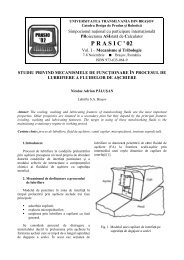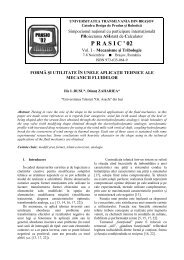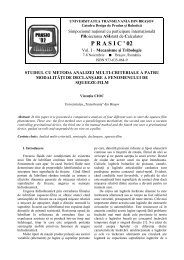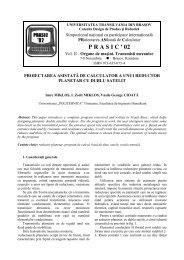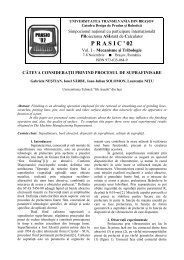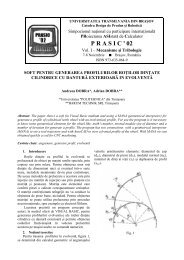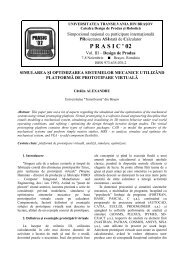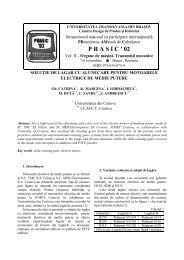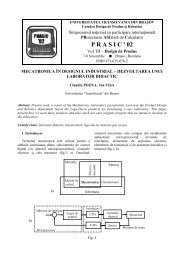real-time mbs formulations: towards virtual engineering
real-time mbs formulations: towards virtual engineering
real-time mbs formulations: towards virtual engineering
Create successful ePaper yourself
Turn your PDF publications into a flip-book with our unique Google optimized e-Paper software.
170 J. Cuadrado, M. Gonzalez, R. Gutierrez, M.A. Naya<br />
dynamics of complex rigid-flexible multi-body systems; b) the experimental validation of the motions,<br />
deformations and forces obtained through the application of the abovementioned <strong>formulations</strong>, so as to<br />
verify that <strong>real</strong>ity is being reasonably well imitated; c) the study of the aptitude of such <strong>formulations</strong><br />
for becoming part of a <strong>virtual</strong> <strong>real</strong>ity environment, in connection with user-interface devices.<br />
The paper has been organized as follows: Section 2 describes a <strong>real</strong>-<strong>time</strong> formulation developed by<br />
the authors for the dynamics of rigid-flexible multi-body systems; Section 3 shows some examples of<br />
rigid-flexible multi-body systems simulated with such formulation, paying attention to the achieved<br />
efficiency, robustness and accuracy; Section 4 reports the results of the experimental validation of one<br />
of the examples; Section 5 presents a simulator based on the proposed formulation; and, finally,<br />
Section 6 summarizes the conclusions of the work.<br />
2. THE REAL-TIME FORMULATION<br />
The three main elements (modeling, dynamic equations and numerical integrator) of the proposed<br />
approach to solve the dynamics of rigid-flexible multi-body systems are described in what follows.<br />
For the modeling, fully-Cartesian coordinates, also known as natural coordinates, are used. Both rigid<br />
and flexible links are modeled with this type of coordinates in a total compatible form. Further<br />
explanation about these coordinates can be found in [1]. The dynamic equations are stated through an<br />
improved version of the index-3 augmented Lagrangian formulation with mass-orthogonal projections<br />
given in [2]. For the integration scheme, the unconditionally-stable implicit single-step trapezoidal rule<br />
has been chosen [3].<br />
2.1 Modeling<br />
The modeling of rigid bodies follows the general rules given in [1], and won’t be described here,<br />
since it can be considered as a well established technique.<br />
The modeling of flexible bodies is carried out by a floating frame of reference approach with<br />
component mode synthesis for small elastic displacements. The global motion of each flexible body is<br />
described as a superposition of the large-amplitude motion of a moving frame, rigidly attached to a<br />
certain point of the body, and the small elastic displacements of the body with respect to an<br />
undeformed configuration, taken as reference. Any deformed configuration of the body is expressed as<br />
a linear combination of static and dynamic modes, in the sense of the mode synthesis approach with<br />
fixed boundaries. The static modes depend on the natural coordinates defined at the joints of the body,<br />
while the number of internal, dynamic modes should be decided by the analyst. A detailed description<br />
of the kinematics of this method can be found in [4].<br />
However, the approach proposed in the abovementioned reference for the dynamics has not been<br />
adopted, as long as it showed to be too involved, particularly in what refers to the form of the inertia<br />
terms. Therefore, the co-rotational approximation suggested in [5] has been considered in the way<br />
proposed by [6] when natural coordinates are used for the modeling. This modified approach provides<br />
the same level of accuracy while notably simplifying the formulation of the mass matrix and velocity<br />
dependent forces vector. In what follows, the approach is<br />
briefly described.<br />
Figure 1 shows a general flexible body. Point r o<br />
and<br />
orthogonal unit vectors a, b and c serve to define the body<br />
local reference frame, and are always needed, so that they<br />
must compulsorily be considered as problem variables.<br />
Additional points and unit vectors (further problem<br />
variables) may be defined at the joints of the body (they<br />
will produce the static modes) in the typical way featured<br />
by the natural coordinates. The position of any point of the<br />
Figure 1. General flexible body.<br />
body can then be expressed as



